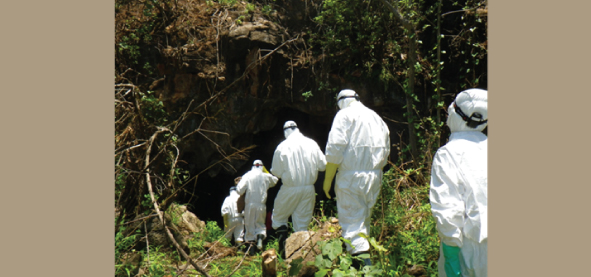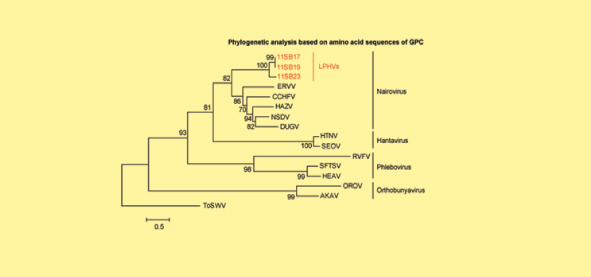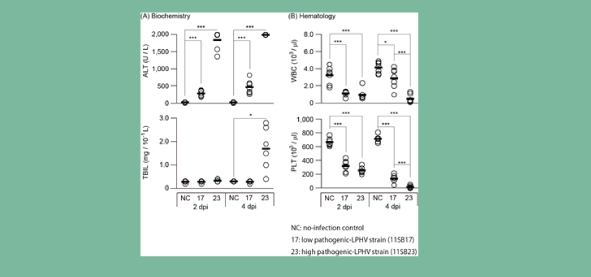A nairovirus isolated from African bats causes hemorrhagic gastroenteritis and severe hepatic disease in mice
Research Press Release | December 10, 2014
-
 Leopards Hill cave in Zambia where we collected the bat samples
Leopards Hill cave in Zambia where we collected the bat samples -
 Phylogenetic analysis of Leopards Hill virus and other viruses in the family bunyaviridae
Phylogenetic analysis of Leopards Hill virus and other viruses in the family bunyaviridae -
 Leopards Hill virus 11SB23 strain injection to mice resulted in (A) liver and kidney dysfunction, (B) leucopenia, and thrombocytopenia
Leopards Hill virus 11SB23 strain injection to mice resulted in (A) liver and kidney dysfunction, (B) leucopenia, and thrombocytopenia
| Press Release | ||
|---|---|---|
| Key Points | ・We discovered and isolated a novel nairovirus, Leopards Hill virus, in wild bats captured in Zambia.
・We constructed a mouse model infected with the nairovirus, which is associated with hemorrhagic fever-like symptoms. ・The established animal model with the Leopards Hill virus is expected to develop treatment and prophylaxis of nairovirus hemorrhagic disease. |
|
| Overview | Bats can carry important zoonotic pathogens. Here we use a combination of next-generation sequencing and classical virus isolation methods to identify novel nairoviruses from bats captured from a cave in Zambia. The virus are hereafter designated as “Leopards Hill virus (LPHV).” When intraperitoneally injected into mice, a low-pathogenic LPHV 11SB17 strain causes only slight body weight loss, whereas a high-pathogenic LPHV 11SB23 strain produces acute and lethal disease closely resembling that observed with Crimean-Congo Hemorrhagic Fever virus in humans. We believe that our LPHV mouse model will be useful for research on the pathogenesis of nairoviral hemorrhagic disease. | |
| Inquiries |
Akihiro Ishii, Assistant Professor, Hokudai Center for Zoonosis Control in Zambia, Research Center for Zoonosis Control, Hokkaido University TEL: +81-11-706-9517 FAX: +81-11-706-7370 E-mail: ishiia@czc.hokudai.ac.jp |
|
|
Japanese Link |
ナイロウイルス出血熱感染マウスモデルの開発にはじめて成功 | |
| Publications |
(Nature Communications, 2014.12.2) |
|
